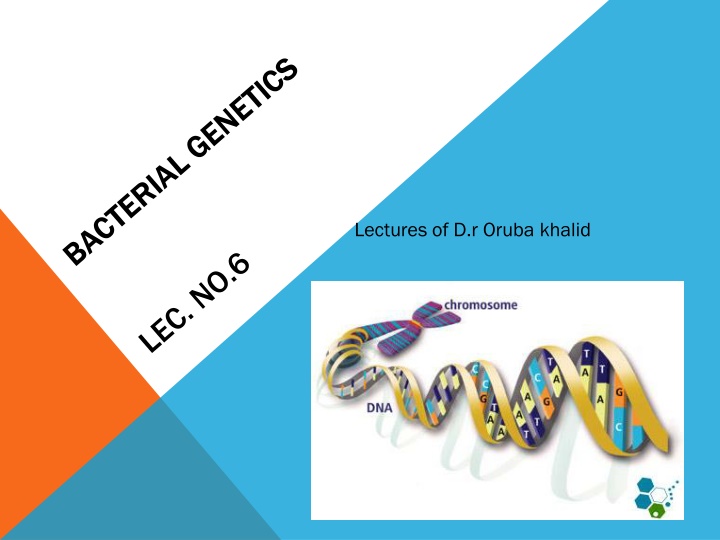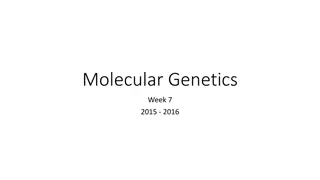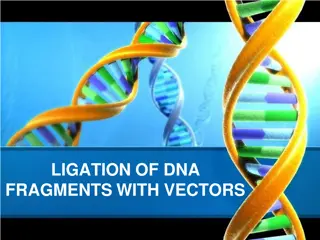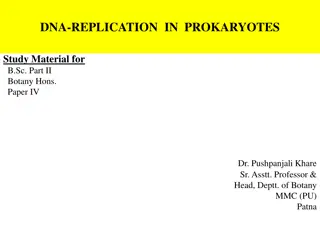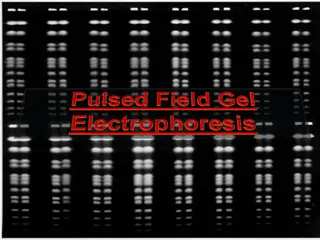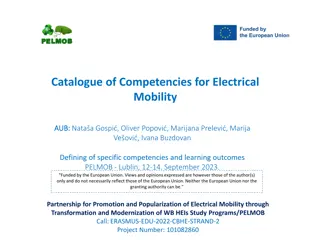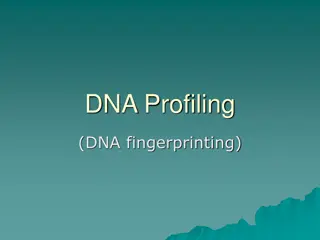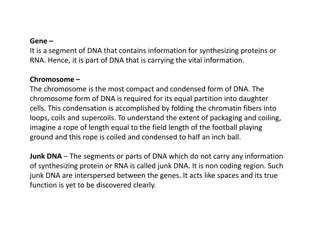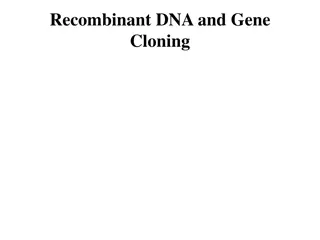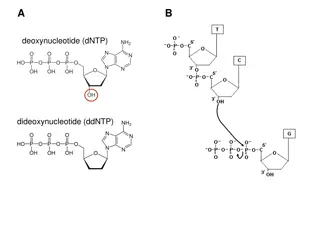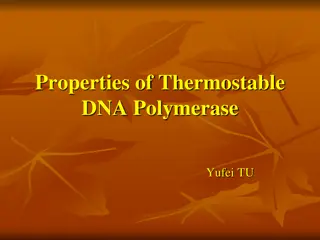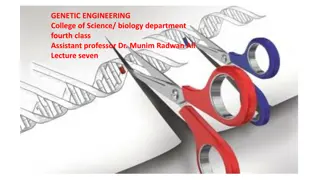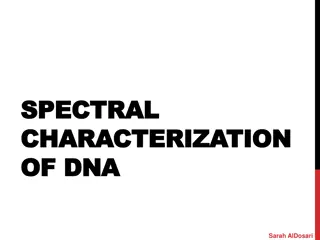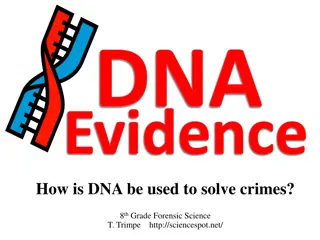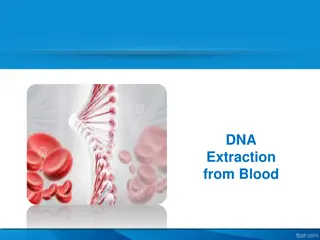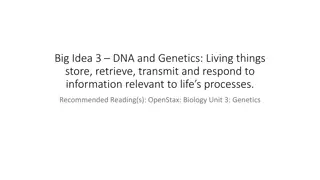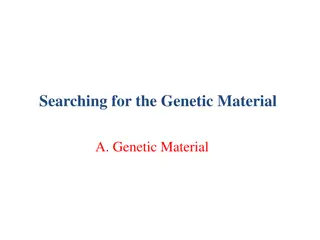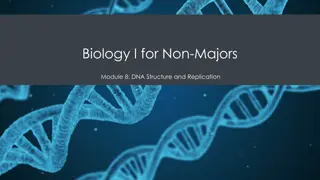Mechanism of DNA Transformation and Competence Development
DNA transformation is a process where cells take up DNA from their surroundings. Competent cells play a key role in this process, releasing a competence factor to induce competence in non-competent cells. The development of competence involves the production of a competence factor that adsorbs to the cell surface, leading to the expression of genes like autolysin. This results in the exposure of nuclease and DNA binding protein, facilitating the transformation mechanism. Understanding how double-stranded DNA is bound, degraded, and integrated into the chromosome provides insights into genotypic changes during the transformation process in various bacterial species like Haemophilus and E. coli.
Download Presentation

Please find below an Image/Link to download the presentation.
The content on the website is provided AS IS for your information and personal use only. It may not be sold, licensed, or shared on other websites without obtaining consent from the author.If you encounter any issues during the download, it is possible that the publisher has removed the file from their server.
You are allowed to download the files provided on this website for personal or commercial use, subject to the condition that they are used lawfully. All files are the property of their respective owners.
The content on the website is provided AS IS for your information and personal use only. It may not be sold, licensed, or shared on other websites without obtaining consent from the author.
E N D
Presentation Transcript
Transformation Transformation
Transformation Occurance 1% Random Naturally in certain species Haemophilus Neisseria Pseudomonas Streptococcus Staphylococcus Griffith experiment Genetic transfer Environmental surroundings Naked DNA assimilated Competent cells Cell wall Plasma membrane Bacterial lysis DNA Plasmids
Transformation Transformation it is the process where the DNA is taken up by the cell from the surrounding medium Not all the cells have the ability of transformation; those that possess this ability are called competent cells. The stage of bacterial cycle and the type of the medium influencing transformation Most of the experiments are done on Streptococcus and Bacillus When cell concentration reaches 107-1010cells/ml. ; all cells become competent Competence factor (an activating protein) is released by competent cell to induce competence in non- competent cells.
Development of competence Development of competence: : Cells produce competence factor C.f. adsorbs on cell surface This lead to expression of certain genes( autolysin) Autolysin is released outside the cell Secretion of autolysin leads to exposure of nuclease and DNA binding protein.
Process of transformation mechanism: Process of transformation mechanism: 1. Double stranded DNA is bound to DNA-binding protein on cell surface 2. Nuclease degrade one strand 3. The remaining single strand will be bound to another type of DNA-binding protein 4. This DNA-binding protein carries it to inside the cell towards the chromosome 5. The chromosome will be opened leading to integration of the carried DNA to it. If correction occurs before replication, no genotypic change will occur, and the transformation process is said to be failed On the other hand, if replication occurs before correction, then two cells will be formed; one containing the original DNA without any genotypic change, and the other cell will possess the newly transformed DNA with genotypic change.
In In Haemophilus Haemophilus influenza competence competence factor rather, rather, the the type the the role role in in making making the Gram Gram- -negative negative bacteria bacteria: : and E E. .coli produced, but type of of the the medium medium plays the cells cells competent such such coli; ; no as as influenza and factor is is produced, no but plays competent. .
Property Property Gram + Gram +ve ve Gram Gram ve ve 1 1 Competence factor triggers competence Competence factor triggers competence Yes Yes No No 2 2 Form of which DNA entres cell Form of which DNA entres cell Single strand Single strand Double strand Double strand 3 3 Source of DNA that can enter the cell Source of DNA that can enter the cell Any Any Only homologous Only homologous 4 4 Physical state of DNA within the cell Physical state of DNA within the cell Protein bound Protein bound none none
Transduction Transduction
Transduction Transduction The virus bacteriophage.not all bacteria are infected by the same phage, but some phages can infect more than one type of bacteria, it means that those bacteria possess the same receptor for that virus. Therefore, transduction: transferring of DNA from one bacteria to another by the help of a bacteriophage. . that infects bacteria is called is the process of
Bacteriophage replication occur in Bacteriophage replication occur in 5 5 stages: stages: 1. 1. Adsorption: where the virus is Adsorption: where the virus is adsorped bacterial cell wall. bacterial cell wall. adsorped on specific receptor on the on specific receptor on the 2. 2. Penetration: the virus make a hole in the bacterial cell wall using its core Penetration: the virus make a hole in the bacterial cell wall using its core and its DNA is passed through this hollow core to inside the and its DNA is passed through this hollow core to inside the bacteria bacteria 3. 3. Replication : the viral nucleic acid controls the bacterial cell activity and Replication : the viral nucleic acid controls the bacterial cell activity and mechanisms for its benefit and synthesize several numbers of the viral mechanisms for its benefit and synthesize several numbers of the viral parts. parts. 4. 4. Maturation : during this stage, each head of a virus will be surround one Maturation : during this stage, each head of a virus will be surround one part of the viral DNA, then the other parts will be joined to each other part of the viral DNA, then the other parts will be joined to each other forming several numbers of viruses. forming several numbers of viruses. 5. 5. Release : finally the virus release a lysozyme that leads to cell Release : finally the virus release a lysozyme that leads to cell lysis release of the viruses, then each virus will infect other bacteria, and so on release of the viruses, then each virus will infect other bacteria, and so on until the until the lysis lysis of the whole colony. of the whole colony. lysis and the and the
Sometimes, during the process of maturation, the viral head takes apeice of bacterial DNA, by mistake, instead of the viral DNA, and continue to attach other parts and released with other viruses. When the virus infect another bacteria, the process of adsorption and penetration are the same, but when the DNA penetrated inside the bacterial cell, one of the following 3 possibilities might happened: 1. The strange DNA might get diagnosed by the cell and immediately digested, and the process is said to be failed. 2. The strange DNA move towards the chromosomes and join with it, and the process of transduction is successeded. 3. The other possibility is that the strange DNA neither digested nor combined with the chromosome, and become as an inert extra chromosomal DNA, does not have any effect and does not replicate with the cell division, this process is called aborative transduction.
Transduction Transfer of bacterial genes via viruses Donor to recipient Virus: Bacteriophages Types Generalized Specialized Replication Cycle Lytic Lysogenic
Sometimes, the recombination of the viral DNA with the chromosomal DNA may lead to a drastic change in the character of the bacteria, such as becoming a powerful toxin producer (e.g. Clostridium botulinum,, Corynebacterium diphtheriae etc). The bacteria are called Lysogenic cell, and the process is called Lysogenic conversion
Mutation Mutation
Genotype Genotype: is the : is the gatalogue gatalogue of gene arranged on the DNA molecule of gene arranged on the DNA molecule. . Phenotype: Phenotype: the collection of characters as result of the expression of the collection of characters as result of the expression of these genes these genes. . Mutation Mutation: : hereitiditary hereitiditary changes occur in the genotype which may or changes occur in the genotype which may or may not lead to phenotypic change. may not lead to phenotypic change.
The physical or the chemical agent that leads to mutation is called mutagen, and the bacteria produced with such genotypic change are called mutants. Mutation occur either spontaneously or by induction. Induced mutation occur as a result of the effect of one of the followings:
A A- -Physical: such as U.V. light, X Physical: such as U.V. light, X- -ray B B- -chemical:such chemical:such as acid, hydroxylamine, nitrogen mustard, acid, hydroxylamine, nitrogen mustard, acridines acridines, , nitrosoguanidine nitrosoguanidine C C- -Biological: such as transposons. Biological: such as transposons. ray etc. etc. as 5 5- -bromouracil, nitrous bromouracil, nitrous etc. etc.
Mutation rate: is the probability of mutation/cell/generation 1x10-4-1x10-10, which varies from one species to another or even in the same species. Wild type : the organism that isolated from nature, and not been exposed to mutagens. Auxotroph : when a mutation occur in the wild type resulting in the requirement of a growth factor such as:amino acid, vitamin, purine or pyridamine base. This is called auxotroph, and written as Aux. His., Aux.Ala., Aux. Bio etc.
When an auxotroph restore synthesis of the growth factor due to another mutation, it is called: His+, Ala+, Bio+, etc. and also called Prototroph. When a wild type His+is exposed to a mutagen and changed to His-, this process is called; forward mutation. There are 9 enzymes involve in the histidine synthesis, therefore; mutation in any of these enzymes will lead to auxotroph His-, in such case , the posibility of forward mutation is much higher. If another mutation occurred at the same site, the organism will restore the synthesis of histidine i.e. His-_____ His+, these organisms are then called revertants, and the mutation process is called true back mutation or reversion mutation. On the other hand, if the mutation did not occur on the same site but rather on another site, this of course will complicate the situation!! And the mutation process is called suppressor mutation.
Types of mutations: 1.Deletion mutation: this result in the loss of a piece of DNA. A B C D E F G______________A B C D F G 2. Inversion mutation:this result in recombining the cut piece in revese order. A B C D E F G_____________A B C E D F G
3 3. . Insertion mutation: Insertion mutation: a totally new base sequence is a totally new base sequence is synthesized and inserted in the DNA molecule. synthesized and inserted in the DNA molecule. A A B C D E F G_____________ B C D E F G_____________A B C K D E F A B C K D E F G G 4 4. . Substitution Substitution mutation: a newly different base sequence is mutation: a newly different base sequence is synthesized instead of the lost synthesized instead of the lost one A B C D E F G______________A B C N E F G A B C D E F G______________A B C N E F G one 5 5. . Duplication mutation: an insertion of a base sequence Duplication mutation: an insertion of a base sequence similar to a sequence already existed similar to a sequence already existed. . A B C D E F G______________A B C D B E F G A B C D E F G______________A B C D B E F G
Genetic Engineering Genetic Engineering a combination of methods which allows to conduct artificial a combination of methods which allows to conduct artificial recombination of DNA and produce chimerical molecules, recombination of DNA and produce chimerical molecules, non non- -typical for nature typical for nature
Main aims of Genetic Engineering: 1. The production of medically useful proteins (somatostotine, insulin, human growth harmone, interferons, interleukin-2, etc.) Recombinant vaccines (hepatitis B vaccine) Gene therapy (involves the insertion of a normal gene into cell to correct a defective gene 2. 3.
Steps in Steps in 1. DNA from any desired source is cleaved into fragments by restriction endonuclease. 2. The fragments are spliced into vector such as plasmid or viral genome. 3. By transformation, the vector is introduced into a host cell in which it can replicate. 4. - After replication of the vector & amplification of the original DNA fragment, vector is isolated. 5. The inserted fragment is cleaved back out & purified. see fig.
Application of molecular cloning:- a. b. c. d. Gene structure \mapping \function e.g. globin. Biosynthesis e.g. insulin, GH (growth hormone), interferon. Control of genetic disease. Using PCR in detection & identification of specific organism e.g. detection of HIV by PCR. Gene therapy. e. NOTE: the field of genetic engineering (molecular cloning) involves the introduction of new genes into the cells.
References: 1- Jawetz, Melnick, & Adelberg s.( 2013). Medical Microbiology (Twenty-Sixth Edition). 2- Kenneth Todar. (2008).Todar s Online Textbook of Bacteriology ,University of Wisconsin. 30
